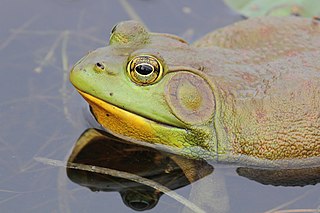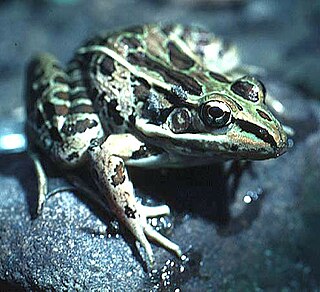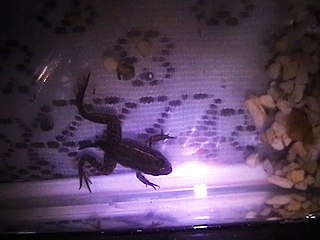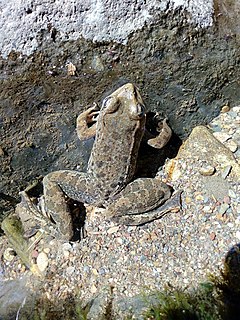
Lithobates is a genus of true frogs, of the family Ranidae. The name is derived from litho- (stone) and the Greek bates, meaning one that treads on rock, or rock climber.

The plateau tiger salamander or Mexican tiger salamander is a species of mole salamander in the family Ambystomatidae. It is typically considered endemic to Mexico, although its range might extend to the United States. Its natural habitat is grassland, including sparse forest and semiarid grassland. Breeding takes place in a range of aquatic habitats: deep volcanic lakes, shallow vernal pools, artificial cattle ponds, and intermittent, fish-free stream pools. It exhibits facultative paedomorphosis.
The Rio Chipillico frog is a species of frog in the family Ranidae, found in Ecuador and Peru. Its natural habitats are tropical forests near fast-flowing rivers; it breeds in pools of water near rivers. It is threatened by habitat loss caused by agricultural expansion and human settlement.
The Lago de las Minas frog is a species of frog in the family Ranidae. It is endemic to the Las Minas Lake in the Oriental Basin of Puebla, Mexico. Its natural habitat is vegetation surrounding the lake. It is threatened by deterioration in the quality of habitat surrounding the lake as well as the decline in lake surface level caused by groundwater extraction.

Forrer's grass frog or Forrer's leopard frog, Lithobates forreri, is a species of frog in the family Ranidae found in Mexico and Central America through Guatemala, El Salvador, Honduras, and Nicaragua to Costa Rica. It is a widespread and common frog found in lowland and seasonal tropical forests. It can also adapt to man-made habitats such as flooded agricultural lands and other water content systems. Reproduction requires permanent pools and lagoons.
Moore's frog is a species of frog in the true frog family (Ranidae). It is endemic to the Sierra Madre Oriental of Mexico.
Lemos-Espinal's leopard frog is a species of frog in the family Ranidae endemic to the Sierra Madre Occidental of southwestern Chihuahua in northern Mexico. Its natural habitats are pine-oak forests. It is threatened by habitat loss.
The Guatemala plateau frog is a species of frog in the family Ranidae. It occurs in Guatemala and southern Mexico. It is impossible to morphologically distinguish this species from Lithobates forreri and Lithobates brownorum, and the validity of it has been questioned. It is an uncommon frog that inhabits cloud forests, including degraded forest, and grassland. Breeding takes place in streams and small temporary ponds. It is threatened by habitat degradation caused by agricultural encroachment, wood extraction, human settlement, and water pollution.
The Northwest Mexico leopard frog is a species of frog in the family Ranidae endemic to Mexico. This predominantly aquatic frog inhabits temporary or permanent pools in shrublands and mesquite forests. It might be threatened by droughts.
The big-footed leopard frog or bigfoot leopard frog, is a species of frog in the family Ranidae endemic to western central Mexico where it is found in the Nayarit, Jalisco, Michoacan, and Guanajuato states.
The island leopard frog or Little Corn Island frog is a species of frogs in the family Ranidae, endemic to Little Corn Island off the Caribbean coast of Nicaragua. It is locally known as rana leopardo isleña.

The Montezuma leopard frog, Lithobates montezumae, is a species of frog in the family Ranidae endemic to Mexico. Its natural habitats are pine-oak or oak forests above 2,000 m (6,600 ft) asl but it can also survive in moderately altered habitats. It breeds in lakes and big pools. It is potentially threatened by habitat loss and introduced predators. It is also collected for human consumption.
The smooth-backed frog is a species of frog in the family Ranidae endemic to Mexico.
The Puebla frog or Pueblan pool frog, Lithobates pueblae, is a species of frog in the family Ranidae endemic to Necaxa River near Huauchinango, Puebla state, Mexico, where it is known as rana poblana. It was thought to probably be extinct until 2010 when Dr. Georg Hantke from the National Museum of Scotland re-discovered it.
The Mexican cascades frog or white-striped frog is a species of frog in the family Ranidae endemic to Mexico, where it is known as rana de cascada.
The Sierra Madre frog is a species of frog in the family Ranidae endemic to the Sierra Madre del Sur in Guerrero and Oaxaca states, Mexico. Its local name is rana de Sierra Madre Occidental. Its natural habitats are conifer forests at intermediate elevations. Breeding takes place in streams. It is threatened by habitat loss (logging) and possibly chytridiomycosis.

The showy leopard frog is a species of frog in the family Ranidae endemic to Mexico.

The Tarahumara frog is a species of frog in the family Ranidae found in Mexico and—formerly—the United States, where it is now regionally extinct. Its natural habitats are streams and plunge pools in canyons in oak and pine-oak woodland, and foothill thorn scrub and tropical deciduous forest in the Pacific coast tropical area. Permanent water is necessary for reproduction.

Tlaloc's leopard frog, or rana de Tláloc in Spanish, is a species of frog in the family Ranidae endemic to the Valley of Mexico. It is most likely extinct.

Zweifel's frog is an amphibian species endemic to Mexico. It is a member of the true frog family, Ranidae.









